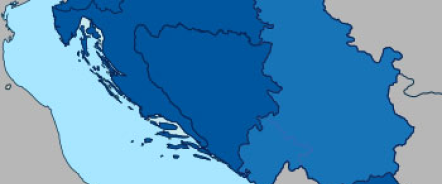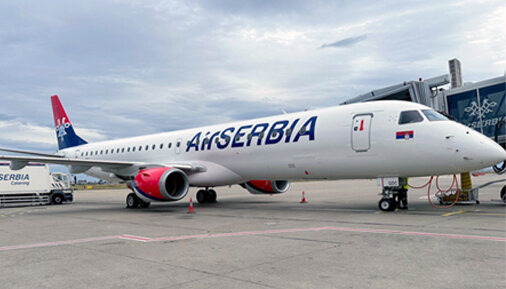Our Story
Air Serbia is the national airline of the Republic of Serbia, the successor of the first national airline, Aeroput, established in Belgrade in 1927. We have been operating under our present name since October 2013.

Air Serbia operates scheduled, seasonal and charter flights to over 90 destinations in Europe, the Mediterranean, North America, Asia and Africa, in passenger and cargo traffic. In cooperation with our airline partners, we also offer flights to international destinations in Asia, Australia, North America and Africa.
In addition to Nikola Tesla Airport in Belgrade, which is our base, Air Serbia also flies from Constantine the Great Airport in Niš and from International Airport Morava near Kraljevo.
Air Serbia is a member of the International Air Transport Association (IATA).
Governing bodies
Air Serbia's governing bodies are the Executive Board, Supervisory Board and the Shareholders' Assembly.
The Executive Board consists of three members, and Jiří Marek is the CEO of Air Serbia since 2022.
Executive Board
Supervisory Board
Shareholders' Assembly
Years to remember
Establishment, growth and termination of Aeroput

1927
The air traffic company Aeroput is established in June. Aeroput, the national airline of the Kingdom of Serbs, Croats and Slovenes, and then of the Kingdom of Yugoslavia, ranks among the top civilian airlines - 10th in Europe and 21st in the world.
1928
A regular route Belgrade-Zagreb is established.
1936
The first flight of aero taxi MMS-3, a unique aircraft manufactured by Aeroput.
1938
Aeroput organises the First international aviation exhibition at the Belgrade Fairground with the participation of Czechoslovakia, England, France, the Netherlands, Germany, Poland, USA and other countries.
1941
The operation of Aeroput was terminated by the Second World War: the pilots and aircraft were mobilized for military aviation and the fleet suffered severe devastation during the enemy bombing of Belgrade.
1942
Occupation authorities ban the operation of Aeroput.
Establishment of JAT and fleet expansion

1947
The tradition of Aeroput is continued by Yugoslav Airlines (JAT). In April, its aircraft fly on the first post-war routes of the newly founded company. At the outset the JAT fleet consists of two C-47s turned into DC-3s and two Junkers JU-52s. The first regular routes are in Yugoslavia: Belgrade-Zagreb-Ljubljana and Zagreb-Sarajevo, with one international route Belgrade-Prague-Warsaw.
Jet aviation era and growth

1963
The first Caravel lands at Belgrade airport, marking the start of jet aviation in Yugoslavia. In the following years the last veterans of the piston fleet of DC-3s and Convairs are retired from operation.
1967
JAT starts its own catering service, to be used later also by Air France.
1969
The first DC-9 joins the JAT fleet, and the first B-707 is soon to follow.
Beginning of the golden age

1971
JAT becomes a member of the Association of European Airlines (AEA).
1974
In November 1974, a JAT B-707 flies around the world on the route Belgrade — Beirut — Bombay — Singapore — Tokyo — Honolulu — Los Angeles — London — Belgrade.
1978
The JAT fleet receives a new addition - the Douglas 10-30 (DC-10), the first wide-body aircraft. This enables direct flights from Belgrade to Chicago, Toronto, New York, Los Angeles, Singapore, Kuala Lumpur, Beijing, Sydney and Melbourne.
JAT is more than flying!

1985
JAT is the first airline in Europe to purchase the then state-of-the-art and later the best-selling aircraft Boeing 737-300 (B737-300).
1987
On the IATA and AEA lists of the largest airlines, JAT ranks 31st in the world and 10th in Europe. At the end of the golden 1980s JAT connects Yugoslavia with 61 world destinations on five continents. JAT has an annual turnover of over five million passengers and 46 thousand tons of goods, with a fleet of 36 aircraft.
The war and JAT crisis

1990
The early 1990s mark the beginning of the hardest period in the history of former Yugoslavia after the Second World War. It brought war, dissolution of the country and sanctions, which first and foremost affected the national airline.
1992
In May, JAT flies to New York for the last time - only two days later USA imposes an air traffic embargo with Yugoslavia. Immediately after that the United Nations imposes economic sanctions, and in June JAT introduces bus routes to Budapest and Timisoara.
JAT Airways and the search for a strategic partner

2003
After 56 years, Yugoslav Airlines is transformed into Jat Airways.
2005
Jat Airways is one of the first airlines to obtain an IATA safety certificate in 2005.
2006
For the first time in 15 years, the national airline ends a business year with a positive result. But in the following years Jat Airways is still trying to find a strategic partner to secure its future.
Strategic partnership and a new chapter in the history of the national airline

2013
On 1 August the national airline of the United Arab Emirates Etihad Airways, Jat Airways and the Government of the Republic of Serbia announce a strategic partnership. Etihad Airways acquires a 49 per cent share in Jat Airways, and Jat Airways is re-branded Air Serbia. Etihad and the Government of the Republic of Serbia commit themselves to investing 40 million USD each and to providing additional funds up to 60 million USD. In October we make the first flight to Abu Dhabi.
2014
In less than a year from the establishment of the company we have added 10 Airbuses to our fleet - eight type A319 aircraft and two type A320 aircraft. For the first time in our long history, our aircraft are flown by women.
2016
Air Serbia makes history as it launches a transatlantic service between Belgrade and New York, reconnecting Serbia and the United States after a break of 24 years.
2020
Based on the contract between the Ministry of Economy of the Government of the Republic of Serbia and Air Serbia, the Serbian national airline was recapitalized, with the Republic of Serbia increasing its ownership share in Air Serbia from 51 to 82 percent, while Etihad Airways' share was reduced from 49 to 18 percent. The increase of the share capital of the Company was undertaken in order to eliminate the disturbances in the economy caused by the pandemic of the infectious disease COVID-19.
2022
We introduce a second wide-body aircraft into our fleet in December and establish a direct connection between Serbia and the People's Republic of China, with flights on the Belgrade-Tianjin route.
2023
In May, Air Serbia establishes direct flights between Belgrade and Chicago after a break of more than 30 years, continuing to expand its operations on the United States market.
The Republic of Serbia becomes the owner of 100 percent of the shares of the Serbian national airline.
2024
September – introducing direct flights to Belgrade and Guangzhou, Air Serbia’s second destination in the People’s Republic of China.
October – expanding the fleet with a third wide-body Airbus A330-200 for our longhaul operations to North America and China.
2025
In January, Air Serbia introduces direct flights between Belgrade and Shanghai in the People’s Republic of China.
Our Fleet
One of Air Serbia’s strategic goals is the continuous modernization of aircraft, control systems and technical support, together with the continuous improvement of our crew.
To provide our passengers with even greater comfort, whatever their flight class, we strengthened our fleet with eight new aircraft in 2022.
Another Airbus A330-200 was added to our fleet for long-haul traffic, bearing the image of the famous scientist and inventor of Serbian origin Mihajlo Pupin.
The turbojet fleet was strengthened with Airbus A319 and A320 aircraft, while the regional fleet was rejuvenated with ATR 72-600s.
In 2024, we welcomed our third wide-body Airbus A330-200, bearing registration mark YU-ARD and the EXPO 2027 visual identity, as well as a new aircraft type in our fleet, the Embraer E-195.





























